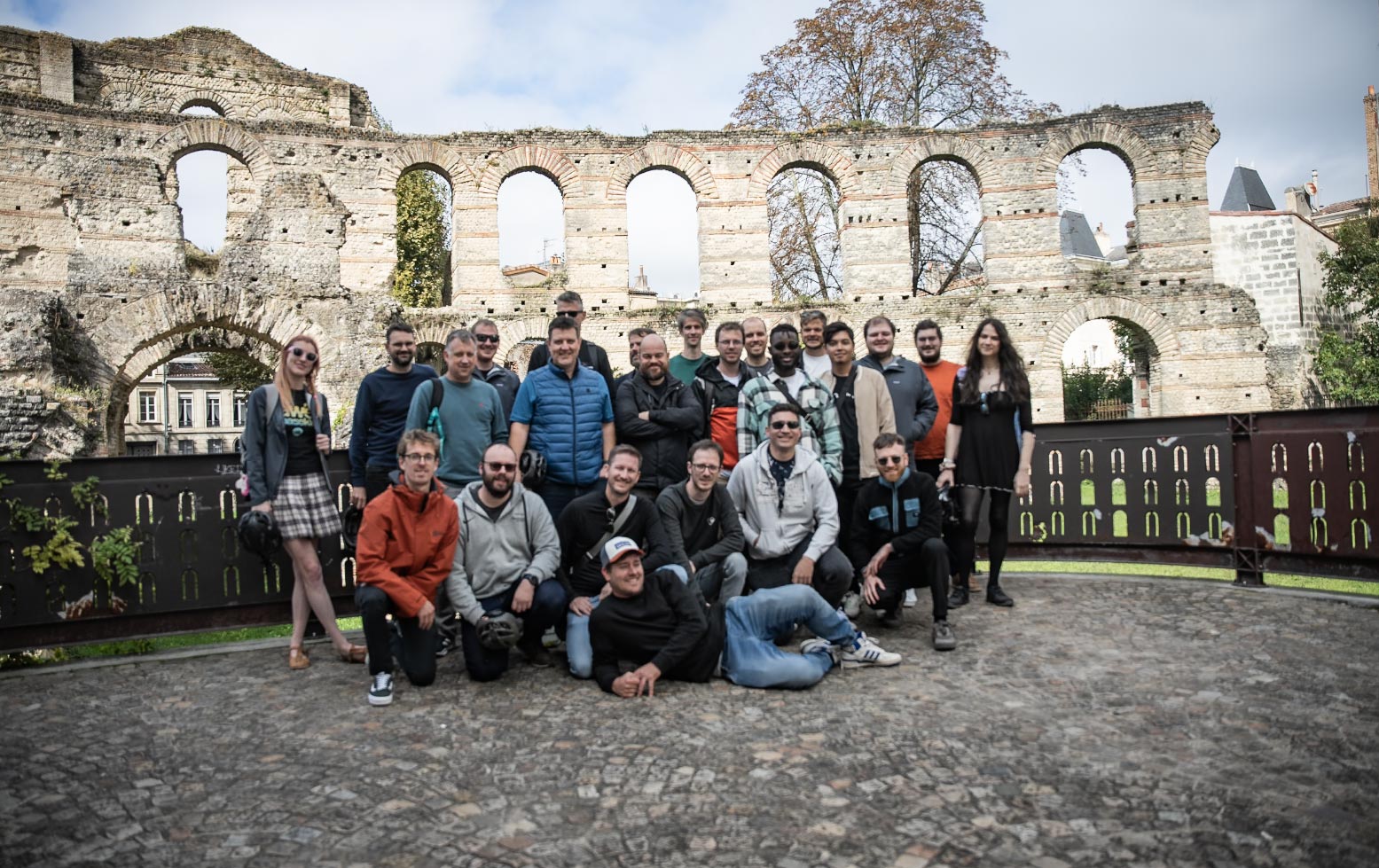Sharing stories over screens
Today’s world is more connected than ever before. Or so we think. Genuine human connection often feels out of reach, especially on the work floor. We’ve got Slack channels for everything under the sun, Zoom calls on the hour, and email threads that stretch longer than “The Lord of the Rings” trilogy. Yet, remote employees can somehow feel like they’re drifting away from each other—disconnected, disoriented, and dispassionate.
At madewithlove, we’re not content with letting that happen. We’ve been a remote-first company for over a decade, even long before the global pandemic hit us. We won’t preach about after-work drinks, ping pong tables, or the work hard, play hard mentality. We have realised that we shouldn’t craft a team but a culture.
Our secret to social cohesion in a remote setting? We use the right tools (and if they don't exist or do precisely what we need, we build them ourselves), provide dedicated bonding time and create a safe culture where individuals can be themselves. Let’s dive in.
Can a philharmonic orchestra play Beethoven remotely?
How to picture working remotely as a team?
Think of a finely equipped 45-person orchestra playing Beethoven’s 9th Symfony. Each musician is seated in their own section, focusing intensely on their music sheet, bowing strings, pressing keys, or blowing horns. But in this orchestra, they’re not sitting in the same opera hall; they’re scattered across the globe and connected only by technology. The conductor’s baton is a Slack message, the music sheet a Notion database, and the only thing holding them together is their ability to sync without being physically present.
When working remotely, this is the reality you’ll face every day. The challenge is ensuring every musician feels part of the same performance, even when they can’t hear each other tuning their instruments or sharing a smile between notes.
At madewithlove, we’ve composed our symphony for remote connection, especially for newcomers, to ensure they won't miss a beat. We’ve found ways to make our team play together as one, even when we’re miles apart.
What to expect from remote colleagues
In a remote setting, people care about feeling connected, valued, and supported. They want to know that their contributions are recognised and that they are part of a cohesive team. It’s important to understand that the expectations from remote colleagues are slightly different than in a traditional office. Here are a few key points:
- Professionalism and reliability: Since remote work relies heavily on trust, colleagues are expected to be reliable and professional. This means meeting deadlines, being responsive, and producing quality work. It’s important to communicate your availability, which can be done using Core Protocols.
- Clear communication and review moments: Open and honest communication is crucial. We hold the same standards for both written and video communication. This includes regular updates on progress, plenty of one-on-one time with leaders and mentors, voicing concerns, and being available for virtual meetings. Coming well-prepared for personal or project review moments is also a must.
- Support and collaboration: Despite the physical distance, remote colleagues should be willing to support each other. It’s up to leadership to create a safe environment for everyone to speak up or say no. This can be through sharing knowledge, pair programming, proper documentation and protocols, offering help, or simply being a sounding board for ideas.
- Respect for boundaries: Remote work often blurs the lines between personal and professional life. Respecting colleagues' time zones, working hours, and personal space is essential. Slack (or any other communication tool) is your office; once you close it, you will no longer be working. Let’s not start creating WhatsApp groups, shall we?
Creating a collaborative culture in a remote context
Weekly syncs to dictate the pace
Our team of 25 syncs every Monday at 2 pm Brussels time for a quick status update and check-in on work priorities. Our colleagues in the East don’t have to get out of bed too early. It’s efficient, run by our CEO, and to the point. The most crucial company-wide updates are shared. This meeting also has room for celebrations, birthdays, and occasional fun activities.
But where the magic really happens is during our Friday syncs. Here, there’s no agenda, no pressure. Conversations drift from hilarious stories about someone’s goldfish escapades to deep dives into cultural differences, like attending a Syrian bachelor party. Sometimes, we don’t really know what to talk about, and the meeting is over rather quickly, just as it would be in the office. There’s something about stepping away from formal topics and letting randomness take the lead. It (partially) mirrors real-world office banter, and these playful moments give us a break from the grind.
Buddy system: the perfect onboarding

For any newcomer, joining a remote team can feel like stepping into a secret society where everyone seems to know their place already and understands the etiquette. That’s where a buddy system can come in handy. A buddy will take the newcomer by the hand and help them blend in by assisting them in understanding the unwritten social norms. Think of things like the nuances of which Slack channel to post in, how to communicate with each other, which meetings to attend, how to manage time tracking, or how vocal to be. A buddy system creates a psychologically safe environment from day one, ensuring newcomers don’t just feel part of the company but part of the team.
Retreats and workations: real-life bonding moments

Once a year, we gather in one (secret) location for our company retreat. Sure, there’s some work involved, but the goal is more profound: it’s about getting to know each other outside of work-related projects, having dinner together, playing games and creating bonds.
Whether hiking through mountains in Slovenia or laughing over a shared meal in Bordeaux, these unsupervised, unstructured moments help build the fabric of our relationships. Of course, there is also plenty of room for presentations, group discussions, workshops, and/or hackathons during a retreat. In the weeks after the retreat, we notice a spark in happiness, more active Slack channels, and better team cohesion. So, even for remote companies, nothing beats an in-person gathering for better team cohesion and culture.
Canopy updates: a window into the lives of our colleagues

Every Monday, we share our weekly plans in a written update. In addition to client-related work, there is also room to share what you’ve been doing over the weekend and your personal life. On Wednesday, Canopy asks us to answer a company-related question, while on Friday, everyone is asked a social or fun question. These updates allow us to get to know one another even better.
Kaffeneio: the engine for small talk

You don’t get the luxury of water cooler chats in a fully remote team. That’s why we created Kaffeneio—a tool that randomly pairs team members for casual, two—to three-person conversations once a week. These chats are short, spontaneous, and mostly about anything but work. To help ease into the conversation, Kaffeneio throws in suggested topics based on personal updates from weekly Canopy updates. It’s the perfect way to simulate those serendipitous moments of connection that would otherwise be lost in a remote setting.
Take Five: a fun and fast-paced async quiz tool

Sometimes, all you need is a little competition to spark banter and bonds. That’s why we created Take Five, a quiz game where teams compete in a rotating seasonal format. At madewithlove, we hold expeditions which run for a couple of months to create space and dedicated time to work on side projects like Take Five.
Take Five is quick (just five minutes) but generates bonding in the Slack channels for bragging rights. The best part? Part of the quiz involves questions about your teammates, helping everyone get to know one another in ways that aren’t always work-related. A little friendly competition can go a long way in pulling a team closer together.
Reach out if you want to give Take Five a go with your team.
Conclusion
Some companies treat remote workers as interchangeable cogs in a machine. There shouldn’t be an expectation to keep backgrounds blurred, avoid personal talk, and “leave home at home.” But here’s the thing: people don’t work in a vacuum. Just as in the opera hall, the real magic happens in the silence between the notes. It’s up to management to understand the rhythm of each individual, make space for solos and find the perfect harmony of the orchestra.
Remote colleagues bring their whole lives into every interaction, whether they intend to or not. At madewithlove, we embrace that. It’s when someone mentions they’ll be late to a meeting because their kid has a dentist appointment or when someone casually shares a photo of their cat—those moments build a real connection.
We value individuality because we know that people are the heartbeat of our company.










Member discussion